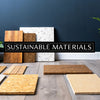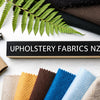Top Green Upholstery Material Ideas for Eco-Friendly Furniture
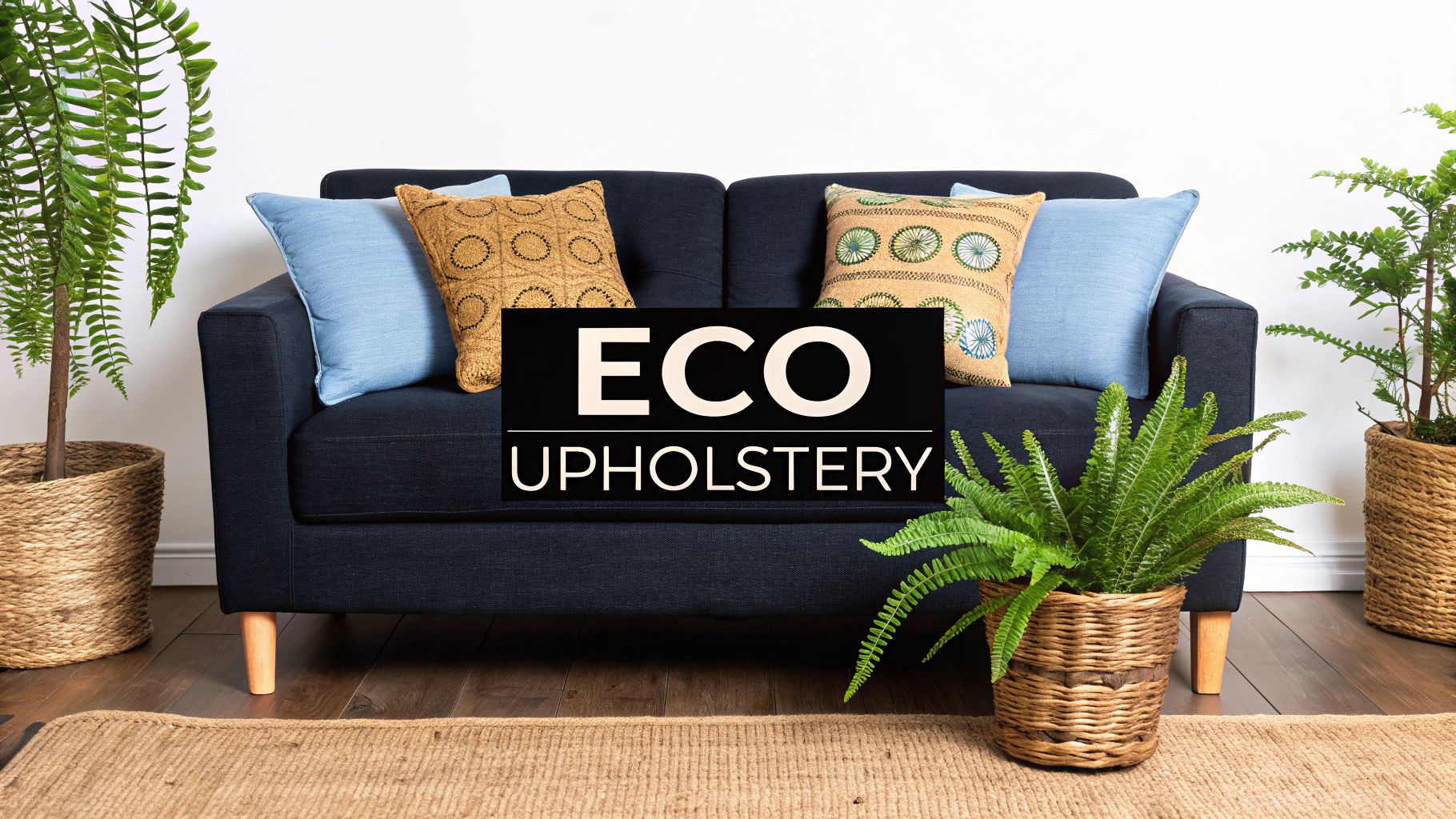
Going Green with Your Furniture: A Guide to Sustainable Upholstery
Looking for eco-friendly furniture options? This guide presents eight green upholstery materials perfect for New Zealand and Australian homes and businesses. Discover sustainable choices, from natural fibers like organic cotton and hemp to innovative plant-based leather and recycled materials. These tools help you create beautiful spaces without compromising the planet. Learn about resources like Maak Home and materials such as Tencel, cork fabric, and recycled polyester, empowering you to make informed, sustainable decisions for your next upholstery project.
1. Maak Home
For Kiwis seeking truly green upholstery material and other interior textiles, Maak Home stands out as a leading choice. This New Zealand-based studio specializes in on-demand, custom-made cushions, fabrics, curtains, and wallpapers, offering a bespoke and eco-conscious approach to interior design. Their commitment to sustainability shines through their zero-waste production model, utilizing cutting-edge digital printing technology that only produces what's ordered, minimizing excess material and environmental impact. This makes them an excellent option for those looking to reduce their footprint while creating unique and stylish interiors.
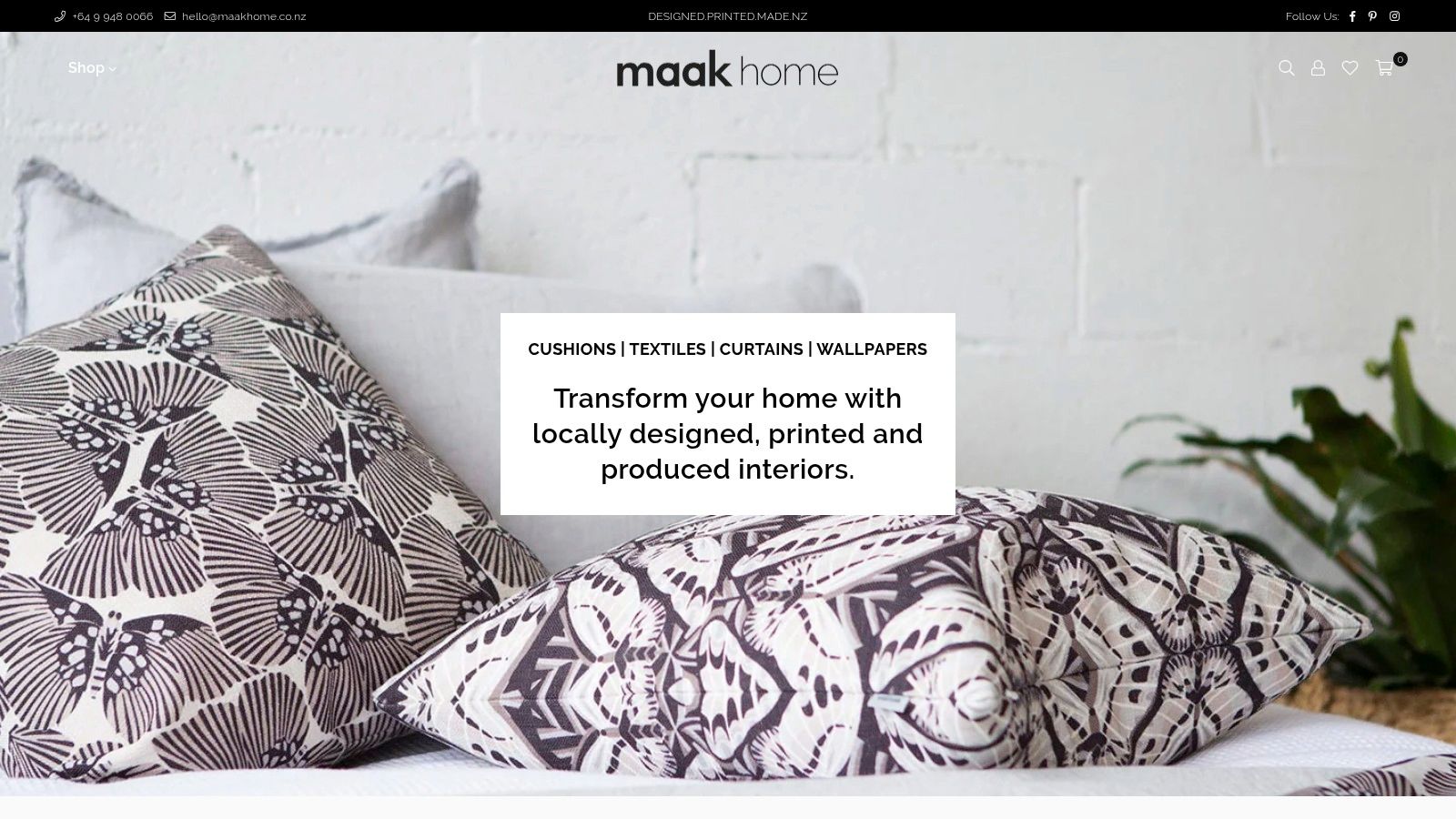
Maak Home's diverse product range caters to a variety of needs and aesthetics. From traditional non-woven fabrics to modern peel-and-stick wallpaper and even waterproof vinyl and grasscloth options, you can find the perfect green upholstery material for your project. Imagine crafting bespoke cushions with a unique print for your living room, or designing a feature wall with a custom-designed, eco-friendly wallpaper. For commercial spaces, Maak Home allows for branded interiors and unique designs that reflect a company's values and style, all while minimizing environmental impact. With fabrics starting at $35, cushions from $70, and wallpapers from $100, you're investing in quality, local craftsmanship, and a sustainable future. Free shipping within New Zealand and Australia makes it even more accessible for local projects. Learn more about Maak Home
While the custom-made nature of Maak Home's products means a slightly higher price point than mass-produced alternatives, the benefits of reduced waste, local manufacturing, and personalized designs make it a worthwhile investment. The current limitation on international shipping beyond New Zealand and Australia might be a drawback for some, but for those within these regions, Maak Home provides an invaluable resource for creating beautiful, sustainable, and truly unique interiors. Their strong customer satisfaction guarantee and dedicated quality assurance also provide peace of mind, ensuring that you'll be happy with your final product. Whether you're an interior designer looking for the perfect green upholstery material, an architect specifying sustainable solutions, or a homeowner passionate about eco-conscious living, Maak Home empowers you to create timeless interiors made right here in Aotearoa.
2. Organic Cotton
Organic cotton is a top choice for green upholstery material, offering a natural and eco-friendly alternative to conventional cotton. Its cultivation avoids synthetic pesticides and fertilizers, significantly reducing its environmental impact compared to conventional cotton production. This makes it a particularly appealing option for environmentally conscious consumers in New Zealand and Australia who are looking for sustainable furnishing solutions. Learn more about Organic Cotton
Its biodegradable and renewable nature further strengthens its position as a green upholstery material. When considering the entire lifecycle of a piece of furniture, the biodegradability of organic cotton ensures it won't contribute to landfill waste in the same way synthetic materials might. This is especially important in the context of growing awareness around waste management and circular economy principles in the region.
For upholstery applications, organic cotton provides a soft, comfortable, and breathable texture. It's hypoallergenic, making it suitable for sensitive skin – a key benefit for homeowners and hospitality businesses alike. While inherently durable, organic cotton is typically blended with other fibres or backed to enhance its strength and resilience for furniture use. This reinforces its structure, making it suitable for the demands of everyday use in furniture pieces like sofas and chairs.
While generally more expensive than conventional cotton, organic cotton offers a premium, eco-conscious choice. While pricing can vary depending on the weight, weave, and specific supplier, you can expect to pay a premium for organic cotton compared to conventional cotton fabrics. The GOTS (Global Organic Textile Standard) certification provides assurance of the organic status and ethical production of the material, giving consumers confidence in their purchase. For commercial projects, specifying GOTS-certified organic cotton can contribute towards green building certifications.
Features and Benefits:
- Grown without synthetic pesticides and fertilizers: Minimises environmental impact and supports sustainable agricultural practices.
- Biodegradable and renewable resource: Reduces landfill waste and promotes a circular economy.
- Hypoallergenic: Suitable for sensitive skin, benefiting both residential and commercial spaces.
- Soft, comfortable, and breathable: Enhances the comfort and well-being of users.
- Various weights and weaves: Offers flexibility for different upholstery applications.
- GOTS certification available: Assures consumers of organic and ethical production.
Pros:
- Supports sustainable agriculture
- Biodegradable at the end of its life cycle
- Soft, breathable, and comfortable
- Hypoallergenic
Cons:
- Higher cost compared to conventional cotton
- Requires more care and maintenance (e.g., professional cleaning)
- Can be less durable than synthetics and might require blending with other fibres for upholstery
- More prone to wrinkling and soiling than synthetic fabrics
Implementation Tips:
- For DIY projects, consider pre-shrinking the fabric before upholstering.
- Consult with a professional upholsterer for complex projects to ensure proper handling and application.
- When choosing organic cotton upholstery, inquire about its blend and backing to ensure it meets the durability requirements of your intended application.
- Look for GOTS certification for guaranteed organic and ethical sourcing.
Organic cotton deserves its place on this list because it strikes a balance between sustainability, comfort, and practicality. It provides a viable option for those seeking to reduce their environmental footprint without compromising on quality and aesthetics, making it an excellent green upholstery material for Kiwi and Aussie homes and businesses. More information on organic cotton facts can be found at https://www.ota.com/organic-cotton-facts.
3. Hemp Upholstery Fabric
Hemp upholstery fabric is a leading contender in the world of green upholstery materials. Derived from the Cannabis sativa plant (industrial hemp), this fabric boasts impressive sustainability credentials. It requires minimal water and absolutely no pesticides to grow, making it a far cry from conventional cotton production which often relies heavily on both. Even better, hemp actually enriches the soil it's grown in, acting as a carbon-negative crop. This means it absorbs more CO2 from the atmosphere than it emits during its lifecycle – a significant advantage for eco-conscious consumers. Its durability is also a key selling point, offering exceptional longevity and resilience for furniture pieces that are meant to last.

Hemp’s robust nature makes it an ideal green upholstery material for high-traffic areas in both residential and commercial settings in New Zealand and Australia. Think family couches, restaurant seating, or even hotel lobbies. Its natural resistance to mold, mildew, and UV damage further adds to its practicality, particularly in humid climates or spaces with lots of sunlight. Imagine a sunroom sofa upholstered in hemp, remaining vibrant and mildew-free despite the exposure to the elements. While it shares a textural similarity with linen, hemp offers greater strength, meaning it's less prone to tearing or wear and tear – perfect for households with pets or children. Over time, hemp upholstery softens with use, developing a beautiful patina that adds character to the furniture.
For interior designers, architects, and commercial property developers seeking sustainable material options, hemp upholstery provides a compelling choice. Its natural antimicrobial and hypoallergenic properties are particularly attractive for hospitality businesses like hotels and restaurants, where hygiene and guest comfort are paramount. DIY enthusiasts and craft lovers will also appreciate the unique texture and durability of hemp for smaller projects like ottomans or accent chairs.
While hemp upholstery fabric earns its place on this list for its numerous eco-friendly advantages, it's important to acknowledge its higher price point compared to conventional fabrics. The limited colour palette, primarily due to the use of natural dyes, can also be a constraint for some design schemes. Additionally, the fabric can feel rough or stiff initially, though it softens considerably with use. It may also wrinkle more readily than synthetic alternatives. For those seeking a truly sustainable and durable green upholstery material, however, the benefits of hemp fabric often outweigh these considerations. You can explore more about hemp fabric and its applications at Hemp Traders.
4. Recycled Polyester (rPET)
Recycled polyester (rPET) is a leading contender in the world of green upholstery materials, offering a compelling blend of sustainability, durability, and affordability. Crafted primarily from post-consumer plastic bottles and waste, rPET transforms plastic pollution into beautiful, functional furniture coverings. This makes it a particularly attractive option for eco-conscious Kiwis and Aussies seeking sustainable solutions for their homes and businesses. Choosing rPET upholstery allows you to actively participate in reducing landfill waste and plastic pollution in our oceans. Its production requires significantly less energy and water than virgin polyester, contributing further to its eco-friendly profile. For upholstery applications, recycled polyester provides excellent durability, stain resistance, and color retention, all while reducing environmental impact.
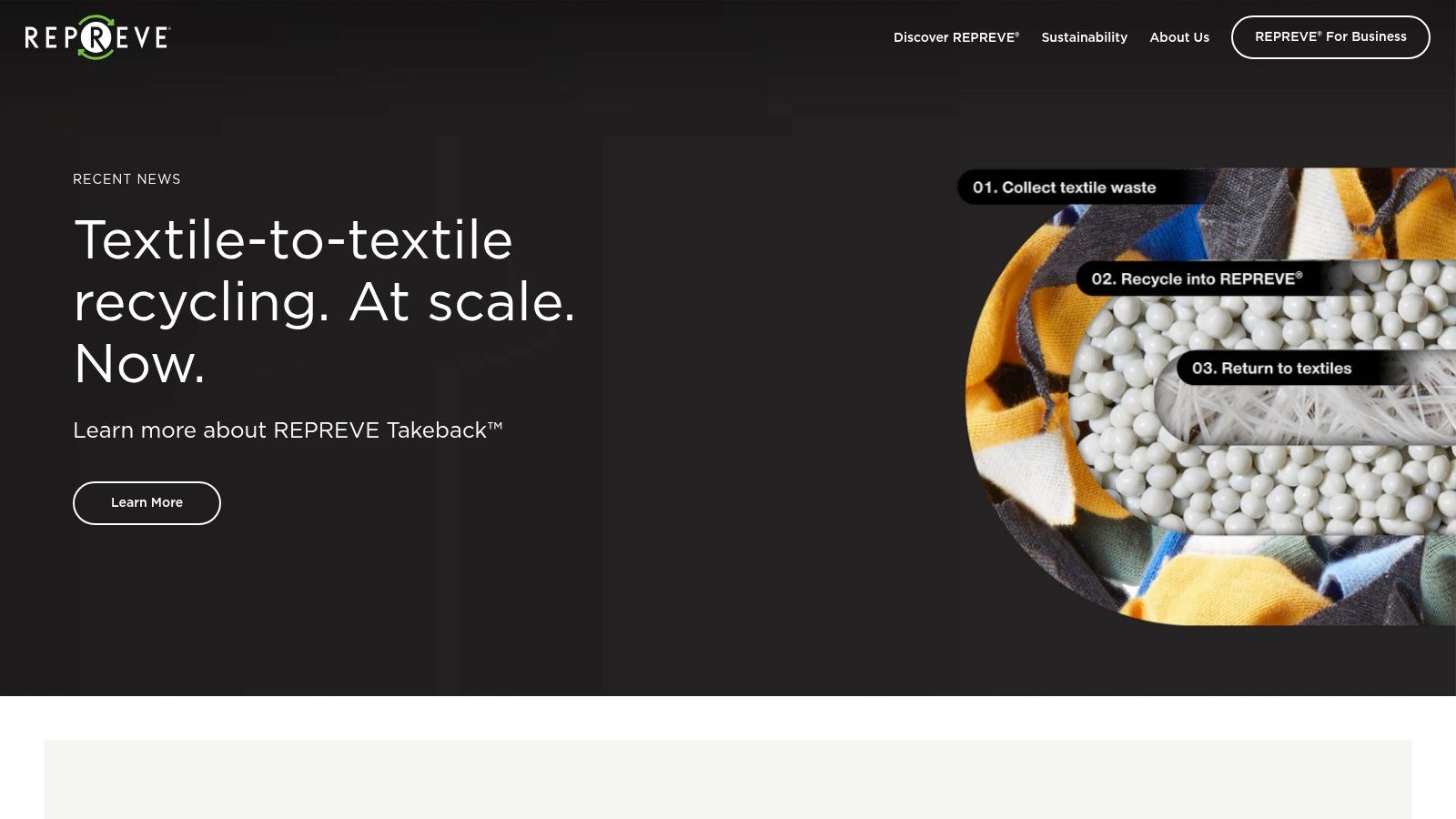
Many manufacturers now offer high-performance recycled polyester fabrics specifically designed for furniture, opening up a world of design possibilities. From sleek and modern sofas to plush and comfortable armchairs, rPET fabrics can be found in a variety of textures and performance grades suitable for both residential and commercial spaces. This versatility makes it an excellent green upholstery material for a wide range of projects. You'll find rPET suitable for everything from reupholstering a vintage armchair to fitting out a bustling restaurant. Learn more about Recycled Polyester (rPET) This resource may offer additional insights into the specific applications and availability of rPET within the NZ market.
One of the biggest advantages of rPET is its durability. It's extremely resistant to wear and tear, making it ideal for high-traffic areas and households with pets or children. Furthermore, its stain-resistant nature simplifies cleaning and maintenance, which is a significant benefit for busy homeowners and commercial establishments like hotels and cafes. While pricing can vary depending on the manufacturer and specific blend, rPET is often a more budget-friendly option compared to natural sustainable alternatives like organic cotton or linen, making it accessible for a wider range of projects.
While recycled polyester is a powerful tool in the fight against plastic pollution, it's essential to be aware of its limitations. As a synthetic material, it can shed microplastics, albeit generally less than virgin polyester. It is also less breathable than natural fibers, which might be a consideration for those living in warmer climates or with sensitivity to synthetic materials. Finally, despite being recycled, rPET ultimately has a petroleum-based origin, and the quality of the fabric can vary based on the percentage of recycled content used. Be sure to check with suppliers about the specific composition and recycled content of the fabric you're considering.
In conclusion, despite these drawbacks, the benefits of using recycled polyester often outweigh the cons. Its durability, stain resistance, lower environmental impact compared to virgin synthetics, and relatively affordable price point make it a worthy contender in the search for green upholstery material. For New Zealand and Australian residents looking for a sustainable and practical upholstery option, rPET offers a compelling choice.
5. Eco-Friendly Wool
Wool, a time-tested natural fibre, offers a compellingly green upholstery material option for discerning consumers and professionals alike. Its inclusion in this list is warranted by its impressive combination of sustainability, durability, and performance characteristics, particularly relevant for the environmentally conscious in New Zealand and Australia.
Eco-friendly wool, unlike conventional wool, comes from sheep raised on sustainably managed farms prioritizing animal welfare and employing environmentally responsible processing methods. This focus on responsible sourcing makes it a truly green upholstery material, perfect for those seeking to minimize their environmental footprint. For upholstery, wool provides a naturally flame-resistant, durable, and resilient covering for furniture, naturally. Its lanolin content further enhances its appeal by providing natural stain-repellent properties.
Features and Benefits:
- Naturally Flame Resistant: Unlike synthetic materials that require chemical treatments, wool is inherently flame-resistant, offering a safer option for upholstery, particularly in commercial settings like hotels and restaurants.
- Durability and Resilience: Wool fibres are renowned for their excellent resilience and shape retention. This ensures your furniture maintains its appearance over time, making it a worthwhile investment.
- Biodegradability and Renewability: At the end of its lifecycle, wool biodegrades completely, returning valuable nutrients to the soil. As a renewable resource, it represents a sustainable choice for upholstery.
- Temperature Regulation and Moisture Management: Wool’s natural breathability allows for excellent temperature regulation and moisture management, making it comfortable in all seasons. This is a particularly attractive feature in the varied climates of New Zealand and Australia.
- Certified Sources: Look for certifications like ZQ, RWS (Responsible Wool Standard), and GOTS (Global Organic Textile Standard) to ensure the wool meets strict environmental and ethical standards regarding animal welfare and processing.
Practical Applications:
Eco-friendly wool is suitable for a wide range of upholstery projects:
- Residential Furniture: From sofas and armchairs to ottomans and headboards, wool upholstery elevates the look and feel of any living space.
- Commercial Spaces: Its durability and flame resistance make it ideal for high-traffic areas in hotels, offices, and restaurants.
- DIY Projects: Wool fabric can be used for smaller projects like reupholstering dining chairs or creating custom cushions.
Pros:
- Extremely durable and can last decades with proper care, offering excellent value for money in the long run.
- Naturally soil and stain resistant due to lanolin content, simplifying cleaning and maintenance.
- Biodegrades completely at end of life, minimizing environmental impact.
- Excellent for all seasons due to its temperature regulation properties.
Cons:
- Higher initial cost than synthetic alternatives, although its longevity can offset this over time.
- May attract moths without proper care, necessitating preventative measures like cedar chips or professional cleaning.
- Can feel scratchy without proper processing; ensure you choose high-quality, finely woven wool upholstery.
- Some ethical concerns around sheep welfare exist if the wool isn't certified. Always opt for certified wool to ensure responsible sourcing.
Pricing and Availability:
Wool upholstery fabric is available from various suppliers in New Zealand and Australia. Prices vary depending on the quality, weave, and certification. Expect to pay a premium compared to synthetic fabrics, but remember this is an investment in quality and sustainability.
Implementation Tip: When choosing wool upholstery, consider the weave and finish. Tighter weaves are more durable and resistant to wear and tear. Consult with a professional upholsterer for advice on the best wool type for your specific project.
For further information on sustainable wool, visit the Woolmark website: https://www.woolmark.com/fiber/sustainability
6. Tencel/Lyocell
Tencel, a branded version of lyocell, stands out as a premier green upholstery material for discerning homeowners, designers, and businesses in New Zealand and Australia seeking both style and sustainability. Derived from sustainably harvested wood pulp, usually eucalyptus, Tencel utilizes a closed-loop production process that minimizes its environmental impact by recycling water and solvents. This eco-friendly approach results in a luxurious fabric with a silky, soft texture and excellent drape, perfect for adding a touch of elegance to any space. Its remarkable moisture management capabilities further enhance its practicality, making it a suitable choice for various upholstery applications.

For New Zealand homeowners, Tencel offers a luxurious and eco-conscious alternative to conventional upholstery fabrics. Its natural breathability and temperature regulation make it ideal for the variable Kiwi climate, keeping furniture comfortable year-round. Imagine sinking into a Tencel-covered sofa after a long day, enjoying its soft, silky feel. Its resistance to bacterial growth is a bonus, contributing to a healthier home environment.
From a design perspective, Tencel's excellent drape allows for beautiful tailoring and creates a sophisticated aesthetic, appealing to interior designers and architects. Its strength and durability, especially when blended with other fibres like linen or hemp, make it a viable option for high-use furniture pieces in both residential and commercial settings. Hospitality businesses such as hotels, cafés, and restaurants can leverage Tencel’s luxurious feel and inherent sustainability to enhance their brand image and appeal to environmentally conscious customers.
While Tencel offers a range of benefits, it's important to consider its limitations. It often requires blending with other fibres for upholstery applications to increase durability and wrinkle resistance. Untreated Tencel can weaken when wet, highlighting the importance of choosing blends or treated fabrics. While pricing can be higher than conventional fabrics, the investment reflects its sustainable production process and superior quality, offering long-term value. Precise pricing details can vary depending on the specific blend and supplier, so it's advisable to contact local fabric retailers or upholstery specialists in NZ for accurate quotes.
Key Features and Benefits:
- Sustainable Production: Made from sustainably harvested wood pulp in a closed-loop process, minimizing environmental impact. This resonates with the growing eco-consciousness in both New Zealand and Australia.
- Biodegradable: Compostable at the end of its life cycle, further minimizing its environmental footprint.
- Water-Efficient: Requires significantly less water (10-20 times less) than cotton production, a crucial advantage in increasingly water-conscious regions.
- Hygienic: Naturally smooth surface resists bacterial growth.
- Comfort: Excellent moisture management and temperature regulation properties offer exceptional comfort.
Pros:
- Luxurious feel and appearance with excellent drape
- Highly sustainable production process
- Soft touch and comfort similar to silk
- Strong and durable when blended with other fibers
Cons:
- Often needs to be blended for upholstery applications
- Can be susceptible to wrinkling
- More expensive than conventional fabrics
- Can weaken when wet unless treated or blended
Website: https://www.tencel.com
Tencel/Lyocell earns its place on this list as a premium green upholstery material due to its unique combination of sustainability, luxurious comfort, and performance characteristics. For those seeking a truly eco-friendly and stylish upholstery option, Tencel offers a compelling choice for a greener, more comfortable future.
7. Cork Fabric
Cork fabric offers a unique blend of sustainability, durability, and distinctive aesthetics, making it a standout choice for green upholstery material. Derived from the bark of the cork oak tree, this material is harvested sustainably every 9-12 years without harming the tree, allowing for continuous regeneration. This process makes it a truly renewable resource, unlike synthetic alternatives. The bark is thinly sliced and adhered to a backing fabric, typically cotton or polyester, to create a flexible and robust upholstery material. This natural material is inherently water-resistant, antimicrobial, and boasts a unique textured appearance that adds visual interest to any piece.

Cork fabric's natural properties make it particularly well-suited for the often-humid climates of New Zealand and Australia. Its inherent resistance to mold, mildew, and insects makes it a low-maintenance option, reducing the need for harsh chemical cleaners. This resistance also contributes to a healthier indoor environment, which is a significant benefit for eco-conscious homeowners and hospitality businesses. From a design perspective, cork offers a distinctive aesthetic that develops a beautiful patina over time, adding character and warmth to any space. It's comfortable and warm to the touch, enhancing the tactile experience of furniture pieces. Imagine stylish cork-upholstered seating in a trendy Auckland cafe or adding a touch of natural elegance to a Wellington home with cork-covered ottomans.
While cork fabric carries a higher price point than conventional upholstery materials, its durability and longevity offset the initial investment. When paired with a natural backing like cotton, it's also biodegradable, minimizing its end-of-life environmental impact. This makes it an attractive option for commercial property developers and fit-out contractors seeking sustainable building solutions. For DIY enthusiasts and craft lovers, cork fabric's lightweight nature makes it easy to work with, opening up possibilities for smaller projects like cushions, headboards, or even decorative wall panels.
Features and Benefits:
- Sustainably Harvested: Doesn't require felling trees, contributing to forest preservation.
- Naturally Water-Resistant and Antimicrobial: Ideal for humid environments and reduces the need for chemical cleaning.
- Unique Texture: Adds visual and tactile appeal to furniture.
- Biodegradable (with natural backing): Minimizes environmental impact.
- Lightweight yet Durable: Easy to work with and offers long-lasting performance.
Pros:
- Distinctive aesthetic with a developing patina.
- Naturally resistant to mold, mildew, and insects.
- Low environmental impact in production.
- Comfortable and warm to the touch.
Cons:
- Limited color options unless dyed (which can impact its eco-friendliness).
- Can tear if not properly backed or reinforced, requiring careful handling during upholstery.
- Higher price point than conventional materials.
- Requires specialized cleaning methods using gentle, pH-neutral cleaners.
Implementation Tips:
- For upholstery projects, ensure the cork fabric is adequately backed and reinforced to prevent tearing.
- Use a sharp blade and strong adhesive for clean cuts and secure bonding.
- Test cleaning solutions on a small, inconspicuous area before applying to the entire surface.
For more information and to explore cork fabric options, visit https://www.corkfabric.com. Cork fabric deserves its place on this list of green upholstery materials because it successfully combines sustainability, durability, and a distinct aesthetic appeal, making it a compelling choice for both residential and commercial applications in New Zealand and beyond.
8. Plant-Based Leather Alternatives
For those seeking a truly green upholstery material, plant-based leather alternatives offer a compelling solution. These innovative materials utilize agricultural byproducts or dedicated crops, like pineapple leaves (Piñatex), cactus (Desserto), and mycelium (Mylo), to create upholstery that mimics the luxurious look and feel of animal leather without the associated environmental impact. This makes them an excellent choice for eco-conscious Kiwis looking to reduce their carbon footprint. These materials offer a sustainable alternative to both traditional leather production and petroleum-based synthetic leathers.
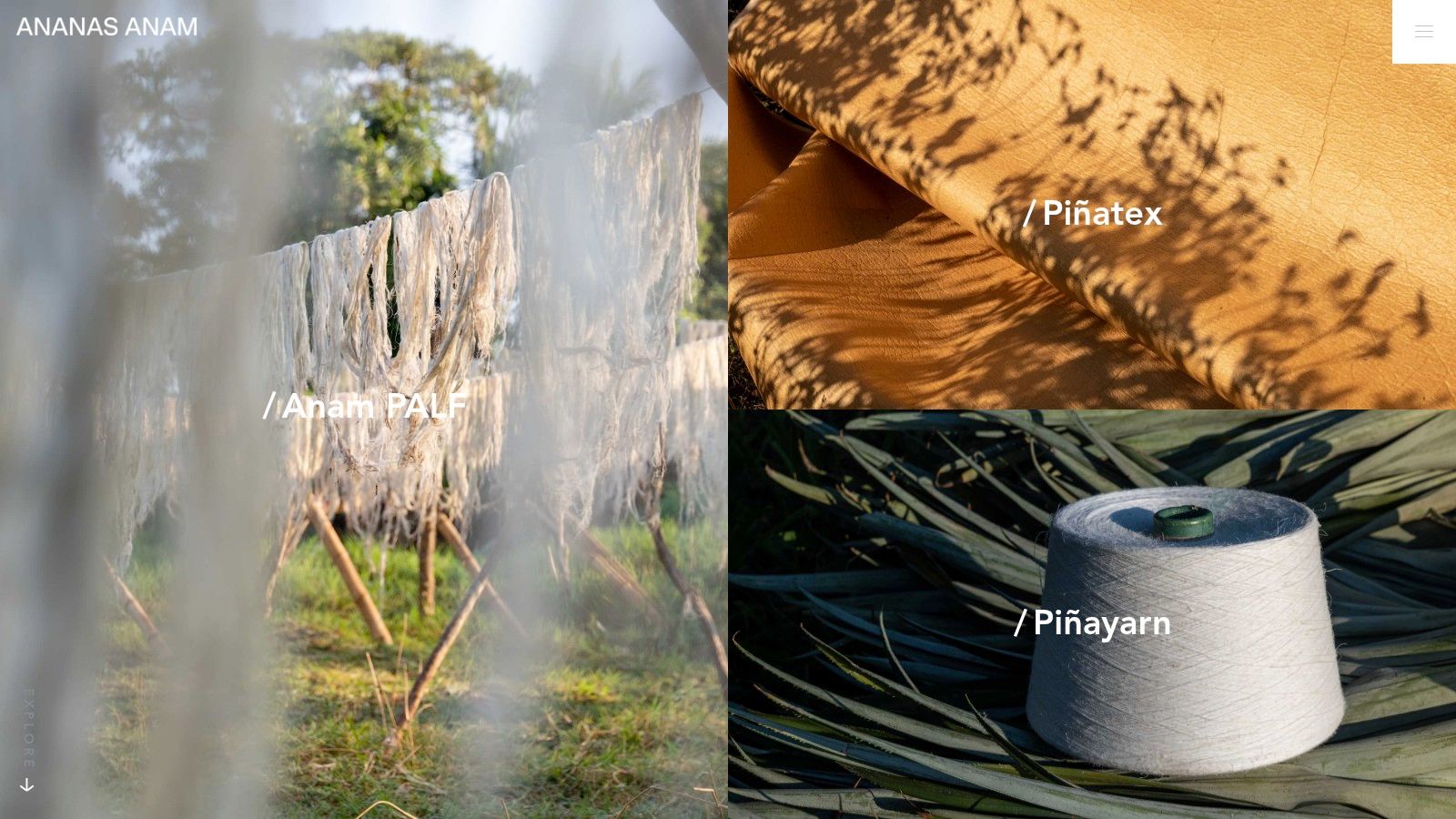
Plant-based leathers are becoming increasingly popular in New Zealand and Australia as homeowners, interior designers, and architects seek more sustainable options. Their versatility makes them suitable for various applications, from sofas and chairs to ottomans and headboards. Imagine a stylish Piñatex armchair in your Auckland living room, or durable Desserto seating in a Wellington café – plant-based leathers offer both aesthetic appeal and eco-friendly credentials. Learn more about Plant-Based Leather Alternatives for deeper insights.
These materials boast several advantages: they're cruelty-free, utilize waste materials or sustainable crops, offer a similar aesthetic and tactile experience to genuine leather, and have a significantly lower environmental impact than both animal leather and synthetic alternatives. They are also available in a variety of textures and finishes, offering design flexibility. For example, Mylo, derived from mushroom roots, offers a remarkably soft and supple texture, while Piñatex boasts a unique, textured finish reflective of its pineapple leaf origins.
However, plant-based leathers also come with some drawbacks. They are generally more expensive than synthetic leather alternatives, and their durability can vary depending on the specific material and manufacturing process. Availability can also be limited as production is still scaling to meet demand. Additionally, some plant-based leathers may require specific care instructions to maintain their appearance and prevent premature wear and tear. While pricing can vary, expect to pay a premium compared to synthetic options. Information on specific technical requirements, like cleaning and maintenance, should be obtained from the manufacturer or supplier.
Compared to traditional leather, plant-based alternatives offer a clear advantage in terms of sustainability and ethical considerations. Compared to synthetic leathers, they present a more environmentally friendly choice, although they may come at a higher price point. For New Zealanders and Australians seeking truly green upholstery material, plant-based leather alternatives deserve a serious look. Visit the Ananas Anam website (https://www.ananas-anam.com) to explore the possibilities of Piñatex and delve deeper into this exciting development in sustainable materials.
Green Upholstery Materials Comparison
| Product | Core Features/Characteristics | User Experience/Quality ★ | Value Proposition 💰 | Target Audience 👥 | Unique Selling Points ✨ |
|---|---|---|---|---|---|
| 🏆 Maak Home | Custom cushions, fabrics, curtains, wallpapers, zero waste | ★★★★★ High-quality, bespoke | 💰 Mid-high, from $35+, free NZ/AU shipping | 👥 Designers, architects, eco-conscious homeowners & businesses | ✨ On-demand printing, sustainable, local NZ manufacturing, quality guarantee |
| Organic Cotton | Grown without pesticides, biodegradable, GOTS certified | ★★★★ Soft, breathable | 💰 Higher than conventional cotton | 👥 Eco-conscious, sensitive skin users | ✨ Hypoallergenic, low environmental impact |
| Hemp Upholstery Fabric | Very durable, mold & UV resistant, soil enriching | ★★★★ Durable, becomes softer | 💰 Higher price point | 👥 High-traffic furniture users, eco-friendly | ✨ Carbon-negative crop, antimicrobial, robust |
| Recycled Polyester (rPET) | Made from plastic bottles, stain-resistant, energy saving | ★★★★ Durable, easy to clean | 💰 Affordable, less than natural fibers | 👥 Budget-conscious, stain-prone environments | ✨ Plastic waste reduction, recyclable |
| Eco-Friendly Wool | Flame resistant, biodegradable, temp regulating | ★★★★ Durable, resilient | 💰 Higher cost | 👥 Premium upholstery, all-season use | ✨ Natural stain resistance, animal welfare certs |
| Tencel/Lyocell | Sustainable wood pulp fiber, silky texture | ★★★★ Soft, luxurious | 💰 Mid-high | 👥 Sustainable luxury upholstery users | ✨ Closed-loop production, excellent moisture control |
| Cork Fabric | Bark-based, water-resistant, antimicrobial | ★★★ Lightweight, durable | 💰 Premium | 👥 Unique aesthetic seekers, eco-conscious | ✨ Renewable harvest, develops patina |
| Plant-Based Leather Alternatives | Made from agri-waste, low carbon footprint | ★★★★ Leather-like feel | 💰 Higher than synthetic leather | 👥 Cruelty-free luxury, innovative material users | ✨ Biodegradable/recyclable, toxin-free tanning |
Creating a Sustainable and Stylish Home with Green Upholstery
From organic cotton to innovative plant-based leather, the world of green upholstery material offers a wealth of choices for the discerning homeowner, designer, or architect. This article has explored eight key materials, each with its own unique benefits and applications. Whether you prioritize durability, a specific aesthetic, or minimizing your environmental footprint, there’s a green upholstery solution to suit your needs. Remember, the most sustainable choice often depends on factors like the intended use, the local climate (especially important here in New Zealand and Australia), and the overall design scheme.
When furnishing your home sustainably, don't forget about other areas like the kitchen. Choosing sustainable materials for your kitchen is just as important, and resources like this guide on eco-friendly kitchen cabinets from Sinclair Cabinetry inc can be invaluable. By considering the entire picture, you can create a truly cohesive and eco-conscious space.
Embracing green upholstery materials is more than just a trend; it's a commitment to a healthier planet and a more stylish, conscious way of living. Start small, ask questions, and explore the exciting possibilities of these innovative materials. For beautiful, handcrafted furniture made with sustainable materials right here in New Zealand, explore the stunning range at Maak Home. Their commitment to eco-friendly practices and exquisite design makes them a perfect choice for those seeking truly green upholstery solutions.





